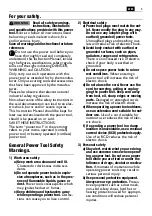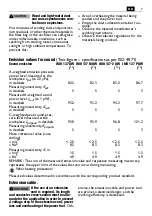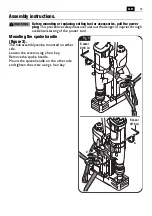
6
en
To prevent injuries, always keep your hands,
clothing, etc. away from rotating swarf.
The
swarf can cause injuries. Always use the
chipping protector.
Do not attempt to remove the cutting tool if
it still turns.
This can lead to serious injuries.
Beware of any concealed electric cables,
gas or water conduits.
Check the working
area before commencing work, e. g. with a
metal detector.
Do not work materials containing magne-
sium.
Danger of fire.
Do not work CFP (carbon-fiber-reinforced
polymer) and materials containing asbestos.
These materials are considered carcinogenic.
Do not rivet or screw any name-plates or
signs onto the power tool.
If the insulation is
damaged, protection against an electric
shock will be ineffective. Adhesive labels are
recommended.
Do not overload the power tool or the stor-
age case and do not use it as a ladder or
stand.
Overloading or standing on the
power tool or the storage case can lead to
the upward shifting of the center of gravity
of the power tool or the storage case, and its
tipping over.
Do not use accessories which are not specif-
ically designed and recommended by the
power tool manufacturer.
Safe operation is
not ensured merely because an accessory
fits your power tool.
Clean the ventilation openings on the power
tool at regular intervals using non-metal
tools.
The blower of the motor draws dust
into the housing. An excessive accumulation
of metallic dust can cause an electrical haz-
ard.
Before storage: Remove the application tool.
Store the power tool only in the case or
packaging.
Before putting into operation, check the
power connection and the power plug for
damage.
Always operate the power tool with together
with a GFCI personal protection switch (*).
Before beginning to work, always check the
proper functioning of the GFCI personal pro-
tection switch (*) (see page 30).
Handling hazardous dusts.
When working with power
tools, such as when grind-
ing, sanding, polishing, sawing or for other
work procedures where material is
removed, dusts develop that are both haz-
ardous to one’s health and can spontane-
ously combust or be explosive.
Contact with or inhaling some dust types
can trigger allergic reactions to the operator
or bystanders and/or lead to respiratory
infections, cancer, birth defects or other
reproductive harm.
Examples of such materials which contain
chemicals that can produce hazardous dusts,
are:
–
Asbestos and materials containing asbes-
tos;
–
Lead-containing coatings, some wood
types such as beech and oak;
–
Minerals and metal;
–
Silicate particles from bricks, concrete
and other materials containing stone;
–
Solvent from solvent-containing paint/
varnish;
–
Arsenic, chromium and other wood pre-
servatives;
–
Materials for pesticide treatment on boat
and ship hulls;
–
Stainless steel dust, metal dust and non-
ferrous metal dust;
To minimize the unwanted intake of these
materials:
–
Use dust extraction matched appropri-
ately for the developing dust.
–
Use personal protective equipment, such
as a P2 filter-class dust protection mask.
–
Provide for good ventilation of the work-
place.
The risk from inhaling dusts depends on
how often these materials are worked.
Materials containing asbestos may only be
worked on by specialists.
WARNING







































